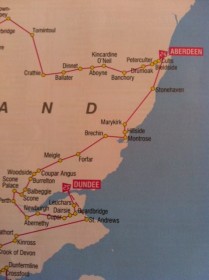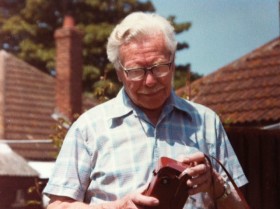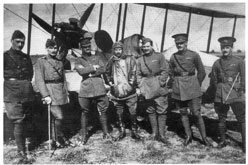Follow the brown signs



The Brown Sign Torch Relay Day 25: Love/hate relationships with flying, ghosts and war dogs

So we’ve started the journey south along the Scottish East coast today from Aberdeen as we spend our penultimate full day in Scotland. The torch goes inland on a little loop around the Firth of Tay and finally on to its destination, Dundee.
About 40 miles south of Aberdeen is the coastal town of Montrose. A quick scout of the area through the medium of t’internet got me interested in the place and especially in an attraction called Montrose Air Station (I am yet to feature an air museum on this torch relay) so I found myself getting immersed in some hardcore interesting research.
I’ve got a bit of a love/hate thing with flying and aeroplanes. I’m a bit of a nerd and therefore I like the engineering side of planes, especially trying to understand the mechanics of how they work and also from a history geek perspective I find it fascinating how quickly and dramatically aeroplanes have changed the world.
 When my grandfather (George, gorgeous man pictured) was born no human had been able to develop any sort of prolonged or practical method of flying, despite trying and failing for millennia (take Icarus’s disastrous attempt as an example) but by the time my grandpa was 60 years old we had implemented the widespread use of aeroplanes with great success in 2 world wars, were flying thousands of people on their holidays overseas every day and had jetted off to the moon and back, many times. To me this is astonishing and it’s so easy not to appreciate it when most of us have grown up seeing hundreds of aeroplanes in the sky above us, but think how unbelievable it must have been for him and his generation to see, and what massive changes flying has made to the world we live in and their effect on the lives we now lead.
When my grandfather (George, gorgeous man pictured) was born no human had been able to develop any sort of prolonged or practical method of flying, despite trying and failing for millennia (take Icarus’s disastrous attempt as an example) but by the time my grandpa was 60 years old we had implemented the widespread use of aeroplanes with great success in 2 world wars, were flying thousands of people on their holidays overseas every day and had jetted off to the moon and back, many times. To me this is astonishing and it’s so easy not to appreciate it when most of us have grown up seeing hundreds of aeroplanes in the sky above us, but think how unbelievable it must have been for him and his generation to see, and what massive changes flying has made to the world we live in and their effect on the lives we now lead.
On the other hand however I don’t like flying because I don’t trust it. I’ve said on previous blogs that when I couldn’t make something happen myself by building it, growing it or doing it with my own two hands then I’m suspicious of it, and therefore flying makes me very suspicious. Don’t get me wrong, I do fly, but whenever there’s the opportunity to take a land or sea option I’ll go for it every time. The primeval bit of my brain (a big part) finds it hard to accept that I’m travelling at 500 miles an hour through the atmosphere, 30,000ft above the ground in little more than a tin can. Drugs and alcohol help damped those feelings of course, and having someone sitting next to me who I can dig my nails into while I push my face into their armpit also dulls the pain, but despite these little comforters that feeling is always with me.
I think great things like aeroplanes are absolutely amazing, the way they’ve changed the world and shot the human race forward leaps and bounds in so many ways is aceballs, but I also think they’re things that we can’t rely on or take for granted and live our lives dependently on, because if we do, then what would happen if we suddenly lost them? Fossil fuels aren’t going to last forever and unless we come up with a way to power aeroplanes from a source that’s not about to run out any time soon then we could see a massive increase in the price of flying and a huge decrease in the amount of flights worldwide. The implications for this would be huge, take the Icelandic volcano eruption a few years ago when air space was shut down to Northern Europe for weeks. There was widespread panic and effects on business and the economy were felt almost immediately (I was in Sardinia researching how to get back to London overland and loving it though, as can imagine). I just think it’s important to be in awe of amazing things like air travel, and to stay amazed, not live our lives assuming they’re a given because if we do then if they disappear we’re screwed.
So I was more interested than normal to read about Montrose Air Station, especially when I found out that it was in fact the first ever operational air station to be established on British soil in 1913. Now (more incredulity) that’s only 10 years after the Wright Brothers made their first ever powered, controlled and sustained flight in the USA, amazing no?! A practical and accessible way of flying had been born and the years after saw a huge surge in aeroplane testing and manufacture worldwide. Unbelievably aeroplanes were being used during in WWI and by WWII the use of planes quite literally took warfare to another level and ultimate Allied victory was in a huge part owed to “the few” who were fighting, not on land but from the skies.
Montrose Air Station has a huge wealth of memorabilia, artefacts, photos, exhibits and aeroplanes on display that chart the history of flight and especially the historic part that Montrose played in flying history, even the 1913 hangers are still standing. The museum is a place for restoring and working on planes too, some of which visitors can actually see happening. The interesting and unique bits that make any museum stand out are present here too, including sections dedicated to “Bamse” an unfailingly protective Norwegian Sea Dog and an exhibition on the important role wartime women played here. A rather amateurish but sweet 2 minute video about the place is below…
As well as the strong flying history RAF Montrose is also well known for it’s ghostly residents. The first reported ghost sighting occurred in 1913 just after Lt Desmond Arthur crashed his plane and died here. Initially the cause of the crash was put down to a faulty repair on the aeroplane but this finding was later overturned and “stunt flying” was reported as the official cause. Visitations from “ghostly apparitions” were reported for 3 years afterwards (we assume Mr Arthur was a bit annoyed that his stunt flying skills were blamed for the crash that killed him), until in 1916 the official cause of the crash was again changed, after repeated eye witness accounts were given that stunt flying was not the cause. Lt Desmond Arthur’s name was finally cleared and the ghost made just one last appearance, then things went quiet. However come WWII there was a resurgence in paranormal activity, including sightings of mysterious bi-planes when no such aircraft were stationed at Montrose, ghostly airmen adorned in flying suit & goggles and ghost riders in the sky, as well as a black Labrador following members of the public around the museum. There’s a whole exhibition space devoted to the ghostly side to RAF Montrose so you can go and scare yourself witless there as well, quality.
 So next time you spot this sign follow it. You’ll be shown the sheer amazingness of flying and hopefully appreciate more how lucky we are to be able to just hop on a flight to anywhere and everywhere. Museums like this one are often manned wholly by volunteers and, let me tell you, air museum volunteers and some of the most passionate and dedicated around. People who want to share their passions with us and do it because they love it, not for the money need to be supported or their knowledge and expertise goes totally to waste and gets lost forever. So go and immerse yourself in an air museum sometime soon, and tell me all about it 🙂
So next time you spot this sign follow it. You’ll be shown the sheer amazingness of flying and hopefully appreciate more how lucky we are to be able to just hop on a flight to anywhere and everywhere. Museums like this one are often manned wholly by volunteers and, let me tell you, air museum volunteers and some of the most passionate and dedicated around. People who want to share their passions with us and do it because they love it, not for the money need to be supported or their knowledge and expertise goes totally to waste and gets lost forever. So go and immerse yourself in an air museum sometime soon, and tell me all about it 🙂







